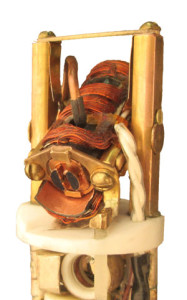Magic Angle Gradient MAS

Coupling field gradients and NMR spectroscopy brings to mind various types of experiments for spatial localization, coherence selection, and solvent signal suppression. In solid state NMR, gradients in combination with magic angle spinning (MAS) can also be utilized in this same manner. However, the use of gradients and MAS has seen a resurgence with quasi-solids (that is, a solid (or semi-solids) that has limited overall mobility, or, rapid internal mobility). For example, a slow setting epoxy could be described as a semi-solid with limited overall mobility. Whereas, an occluded solvent within a solid sample could be described as a solid sample with a component that exhibits rapid internal mobility. Depending upon the quality of the field gradient, experiments can be envisioned which will either enhance or attenuate that portion of the sample that gives rise to such motional extremes.
Gradient pulses in MAS NMR, when applied to components with rapid mobility will exhibit attenuated signals; for example water (or other small molecule) signals with rapid self diffusion can be effectively suppressed. The removal of a solvent signal, or the identification of mobile components, by diffusion edited experiments (DE 1H NMR) is widely useful, as are gradient pulses in 2-D NMR spectroscopy, using experimental techniques that lead to artifact removal. Another important application of gradient pulses is performed on systems consisting of macromolecules or aggregates, in which certain components have restricted mobility. In these systems, gradients can be used for measurement of diffusion coefficients, providing important information on structure and interactions.
A precise linear gradient, directed along the magic angle spinner axis is critical for MAS-NMR, ensuring a rotating spin will always sample the same magnetic field strength. Doty’s Magic Angle Gradient (MAG) is superbly designed with multi-layer, rotated, off-set, heavy Roemer coils, mounted on the outside of the spinner assembly, for greatly improved efficiency and recovery time. Our numerical optimizations, which addressed DC efficiency, switching efficiency, linearity, and harmonic purity, have enabled the development of our MAG coil capable of achieving over twice the gradient strength found in other commercially available MAG coils. Another important advantage is its exceptionally low eddy currents, typically 30 us Pulsed gradients of up to 600 G/cm at 9.4 T can elucidate the smallest diffusion coefficients; measured at 4×10-10 m2/s for F- in a polymeric fluoride ion conductor1 using a Doty 4 mm MAS/MAG NMR probe.
(1) Pasquini L, Ziarelli F, Viel S, Di Vona ML, Knauth P., ChemPhysChem. 2015, 17, 363. Fluoride-ion-conducting Polymers: Ionic Conductivity and Fluoride Ion Diffusion Coefficient in Quaternized Polysulfones.
For information on Doty Magic Angle Gradient MAS/MAG Probes, click here!

